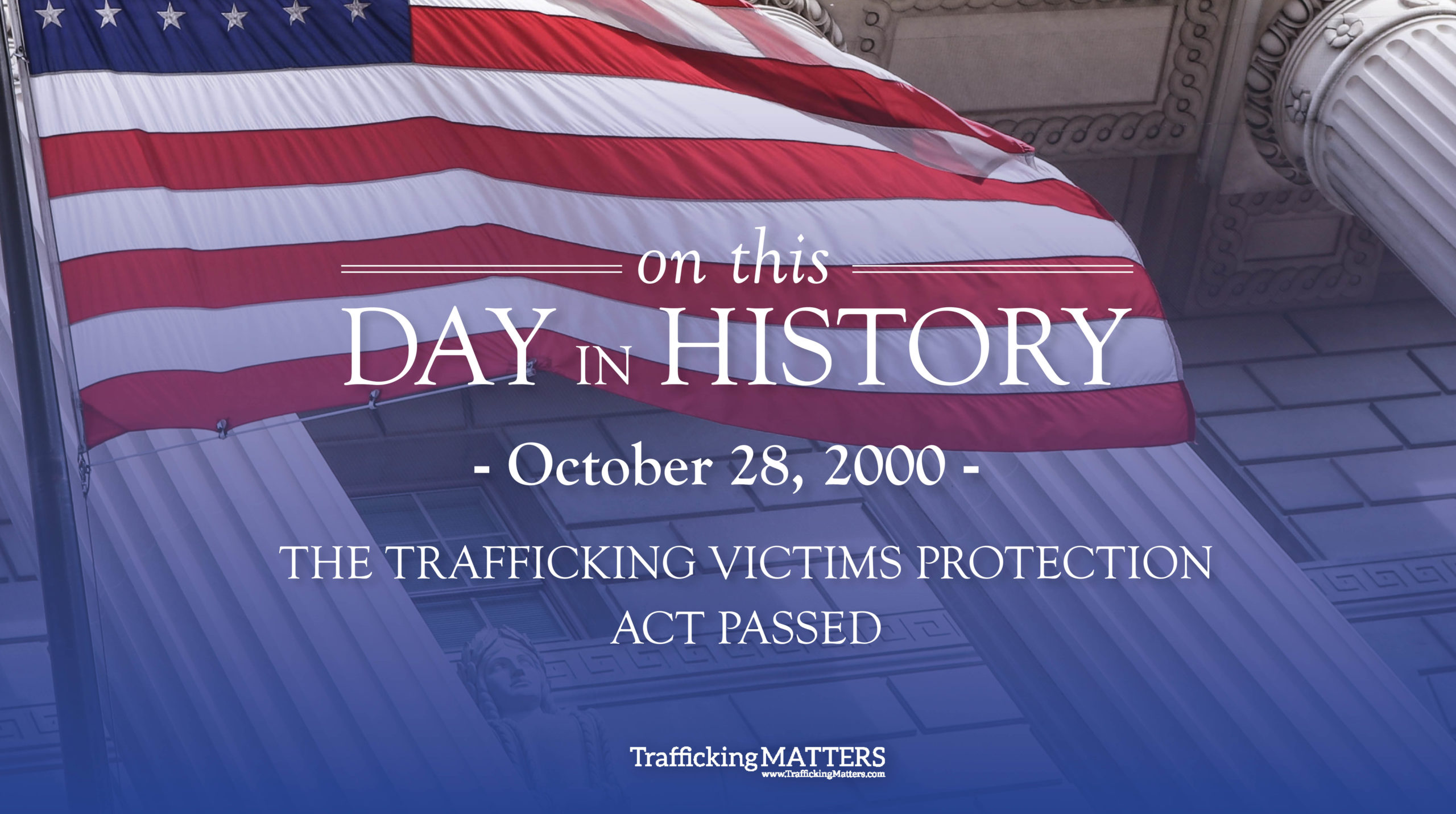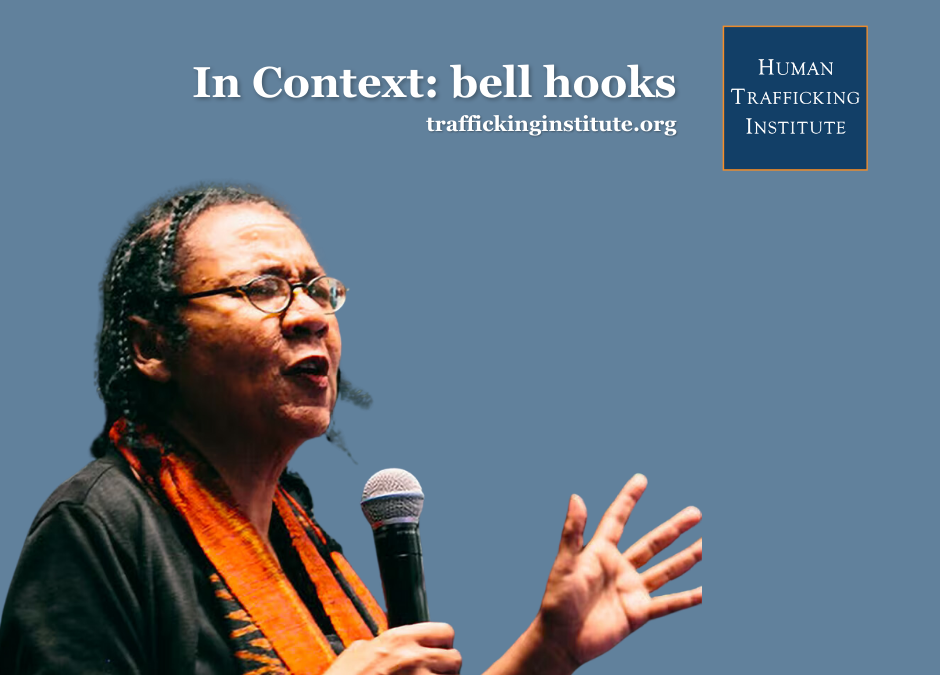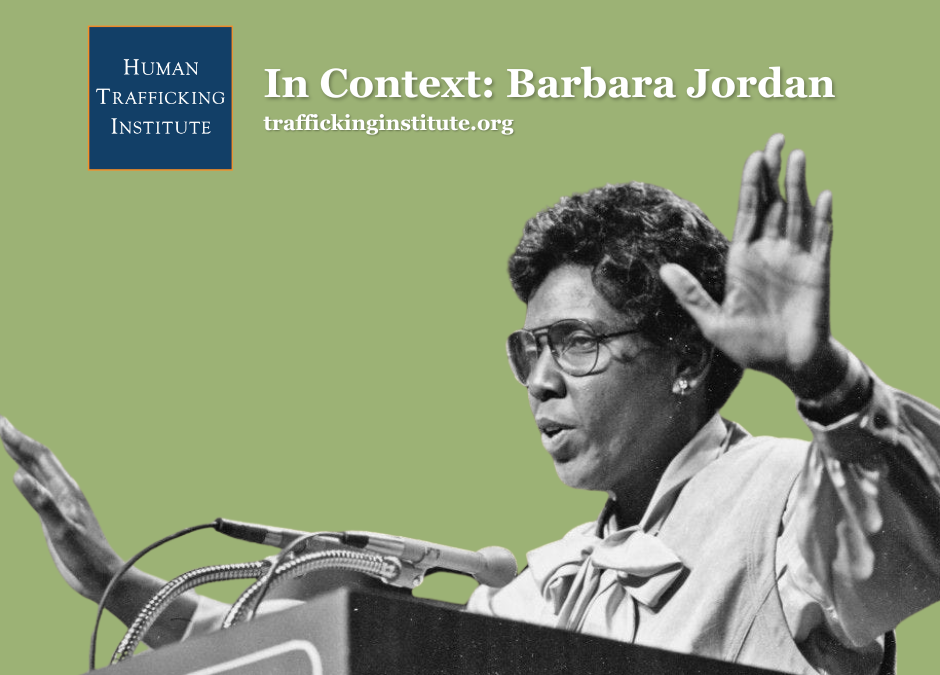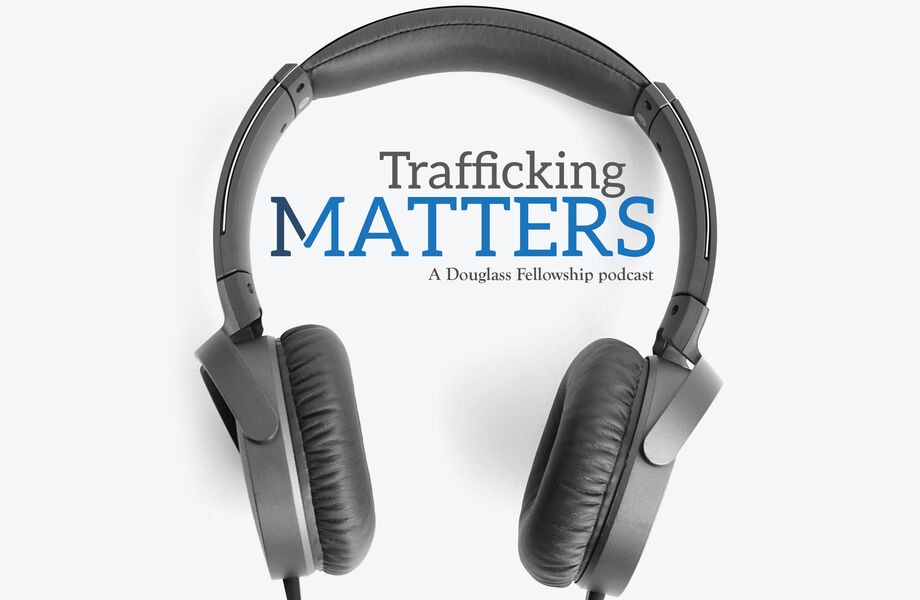By: REBECCA JUN
What is the TVPA?
Today, Americans are increasingly more conscious of human trafficking both inside and outside the United States. Hotline numbers appear on bathroom stalls and calls for awareness echo over airport intercoms. However, there was a time when the definition of human trafficking was murky, and the consequences were almost nonexistent.
On this day in history – October 28, 2000 – Congress passed the bipartisan Trafficking Victims Protection Act (TVPA), and President Clinton signed the first federal law to address human trafficking.1 The TVPA of 2000 is the anchor for federal human trafficking legislation in the United States. It established trafficking and similar offenses as federal crimes, securing severe penalties for them.2
Before the TVPA, human trafficking was not treated as a distinct form of crime. Prior to the 2000s, there was neither specific legislation against human trafficking around the world nor clear international collaboration among law enforcement and other agencies.3 An international platform to discuss such a crime and to delineate clear consequences was missing.
Discussions danced around the issue of human rights. In 1975, a series of conferences called “the Decade for Women,” focused on women’s issues in the international arena as women discussed their stories of oppression and strategized globally.4 Then, in 1979, the United Nations hosted the Convention on the Elimination of All Forms of Discrimination against Women, “bringing the female half of humanity into the focus of human rights concerns.”5
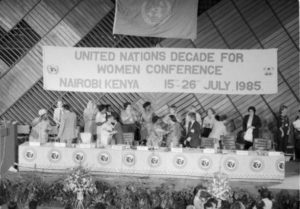
1985 Beijing Conference. United Nations System Chief Executives Board for Coordination.
Throughout the 1990s, the international community felt the growing imprint of human trafficking due to post-Cold War globalization and the overall global environment. The “Decade for Women” marked escalating attention on women’s rights and an increasingly global mindset focused on rising transnational organized crime. Additionally, international labor and human rights advocates formed an alliance to build “a wide-ranging discourse of workers’ rights as human rights.”6 The parallel focus on international women’s rights, organized crime, and labor issues turned the wheels to discuss human trafficking, setting the stage for the 1993 Vienna International Conference on Human Rights and parsing out a better understanding of human trafficking.7
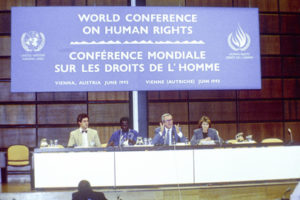
World Conference on Human Rights Held 14-25 June 1993. United Nations Media.
Despite growing attention on human rights issues, human trafficking still needed a legal framework in the United States. Most countries lacked legislation and partnerships to institute repercussions, and as transnational organized crime became more prevalent, countries needed to collaborate on a call to action.8
Palermo Protocol: Setup for The TVPA
In response, the international community collaborated to produce the Palermo Protocol: a “protocol to Prevent, Suppress, and Punish Trafficking in Persons, Especially [among] Women and Children… [a] tool enabling the international community to combat human trafficking.” Sergio Vento, the Italian delegate to the United Nations, praised the protocol for “[paying] equal attention to the repression of illegal conduct and the protection of the victims, [filling] in many gaps in international law and provid[ing] an effective instrument for international cooperation.” 9 The protocol was revolutionary, outlining concrete methods to deter traffickers, although prosecution rates remained very low.
While the Palermo Protocol was a groundbreaking spotlight over trafficking, this approach was limited. Countries needed to take individual responsibility to turn the page and battle human trafficking inside their own borders.10
The TVPA
In 2000, the United States reinforced the Protocol by enacting the Trafficking Victims Protection Act.11
The TVPA clearly defined what constituted trafficking in the United States: sex and labor trafficking.12
- Sex trafficking is: “the recruitment, harboring, transportation, provision, obtaining, patronizing, or soliciting of a person for the purposes of a commercial sex act, in which the commercial sex act is induced by force, fraud, or coercion, or in which the person induced to perform such an act has not attained 18 years of age.”13
- Labor trafficking is “the recruitment, harboring, transportation, provision, or obtaining of a person for labor or services, through the use of force, fraud, or coercion for the purposes of subjection to involuntary servitude, peonage, debt bondage, or slavery.”14
Drawing upon these distinct definitions, the law is three-pronged, focusing on prevention, protection, and prosecution. Each prong delineates the United States’ efforts to combat trafficking.
- Protection: The law provided assistance and funding services for victims and established the T visa, which allows victims and certain family members to remain in the United States for up to four years and also can allow eligibility to become lawful permanent residents.15
- Prosecution: The law bolstered U.S. Government efforts to prosecute traffickers and recognized trafficking as any use of force, fraud, or coercion.16
- Prevention: The law increased preventative measures by authorizing the U.S. Government to help foreign countries through research and assistance to create programs and implement effective processes for investigation.17
Additionally, the TVPA established the U.S. Department of State’s Office to Monitor and Combat Trafficking in Persons and a requirement to publish an annual Trafficking in Persons (TIP) report describing and ranking the efforts every country is taking to combat trafficking.
Reauthorizations
Since October 28, 2000, reauthorizations of the TVPA continue to hinder traffickers and protect victims.
- Trafficking Victims Protection Reauthorization Act of 2003: Established a federal and civil authority for victims to sue traffickers, labeled human trafficking as a crime under the Racketeering Influenced and Corrupt Organizations (RICO) statute, and protected victims and their families from deportation.
- Trafficking Victims Protection Reauthorization Act of 2005: Included new initiatives to shelter minor survivors and to jumpstart state and local law enforcement, expanded efforts to combat trafficking internationally including a pilot program abroad, and strengthened regulation over government contracts.
- Trafficking Victims Protection Reauthorization Act of 2008: Required the U.S. Government to provide information about workers’ rights for those applying for work and education visas, installed new systems to gather human trafficking data, expanded protections from the T visa, and required unaccompanied, undocumented children to be screened as possible victims.
- Trafficking Victims Protection Reauthorization Act of 2013: Included the establishment of the Child Protection Compact program by entering into agreements with countries to provide technical and financial assistance to eradicate the exploitation of children. It focused on trafficking expertise in disaster relief situations and substantiated the relationship between state and local law enforcement to ease charging and prosecuting traffickers.18
- Trafficking Victims Protection Reauthorization Act of 2018: Increased authorized funds for victim services, outlined requirements and standards to train front-line workers in susceptible industries for trafficking, and strengthened the U.S. Department of State’s Trafficking in Persons Report by providing more accurately analyzed and ranked country reports.19 Also established human trafficking prosecutors in every federal judicial district and required the U.S. Department of Homeland Security and the U.S. Department of Justice to create a new victim-centered protocols.
Looking Forward
The TVPA was America’s response to the rampant crime of human trafficking, and it has radically pivoted the nation’s approach. According to the 2019 Trafficking in Persons (TIP) Report, U.S. efforts include increasing the number of convictions, increasing funding for victim services and number of victims served, seeking to invite survivor input on trafficking programs and policies and initiating public outreach programs to more sectors.
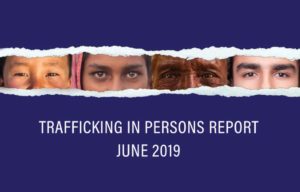
2019 Trafficking In Persons Report. United States Department of State.
However, this is just the beginning to combat the fastest-growing criminal operation in the world. The TIP Report documented 24.9 million total victims of human trafficking today; that is about three times the population of New York City.20 In 2018, worldwide, 11,000 traffickers were prosecuted compared to the 85,613 victims identified.21
There is an overall positive correlation between the implementation of anti-trafficking strategies and identifications of victims, according to the UNODC’s 2018 Global Report on Trafficking in Persons. However, funding will likely be the biggest challenge to keep up with the climbing number of cases and an attempt to close the enormous gap between victims identified and prosecutions. Looking forward, the next reauthorization, scheduled for 2021, will be essential to cementing and effectively modifying the TVPA, serving as an opportunity to grow from this day in history.22
- 1 “Summary of the Trafficking Victims Protection Act (TVPA) and Reauthorizations FY 2017.” Alliance To End Slavery and Trafficking, March 10, 2016. https://endslaveryandtrafficking.org/summary-trafficking-victims-protection-act-tvpa-reauthorizations-fy-2017-2/.
- 2 “Current Federal Laws.” Polaris, October 17, 2016. https://polarisproject.org/current-federal-laws.
- 3 Makei, Vladimir. “Human Trafficking in the Post-Cold War Period: Towards a Comprehensive Approach.” Columbia Journal of International Affairs, January 29, 2013. https://jia.sipa.columbia.edu/online-articles/human-trafficking-post-cold-war-period-towards-comprehensive-approach.
- 4 Chaban, Stephanie. “UN Decade for Women.” The Wiley Blackwell Encyclopedia of Gender and Sexuality Studies, April 21, 2016. https://doi.org/10.1002/9781118663219.wbegss340.
- 5 “Convention on the Elimination of All Forms of Discrimination against Women.” OHCHR. Accessed October 2, 2019. https://www.ohchr.org/EN/ProfessionalInterest/Pages/CEDAW.aspx.
- 6 Compa, Lance. “Labor’s New Opening to International Human Rights Standards.” Cornell University, ILR School, March 2008. https://digitalcommons.ilr.cornell.edu/cgi/viewcontent.cgi?referer=&httpsredir=1&article=1378&context=articles.
- 7 Makei, Vladimir. “Human Trafficking in the Post-Cold War Period: Towards a Comprehensive Approach.” Columbia Journal of International Affairs, January 29, 2013. https://jia.sipa.columbia.edu/online-articles/human-trafficking-post-cold-war-period-towards-comprehensive-approach.
- 8 Id.
- 9 Shoaps, Laura. “Room For Improvement: Palermo Protocol And The Trafficking Victims Protection Act.” Lewis and Clark Law Review 17, no. 3. Accessed September 24, 2918. https://law.lclark.edu/live/files/15325-lcb173art6shoaps.pdf.
- 10 Id.
- 11 Id.
- 12 “Federal Law.” National Human Trafficking Hotline, September 26, 2016. https://humantraffickinghotline.org/what-human-trafficking/federal-law.
- 13 Id.
- 14 Id.
- 15 “Current Federal Laws.” Polaris, October 17, 2016. https://polarisproject.org/current-federal-laws.
- 16 “Summary of the Trafficking Victims Protection Act (TVPA) and Reauthorizations FY 2017.” Alliance To End Slavery and Trafficking, March 10, 2016. https://endslaveryandtrafficking.org/summary-trafficking-victims-protection-act-tvpa-reauthorizations-fy-2017-2/.
- 17 Id.
- 18 “About the TVPRA.” The Freedom Commons | International Justice Mission, October 2, 2012. https://freedomcommons.ijm.org/resources/about-tvpra.
- 19 “Congress Passes Trafficking Victims Protection Act Reauthorization.” Polaris, February 6, 2019. https://polarisproject.org/news/press-releases/congress-passes-trafficking-victims-protection-act-reauthorization.
- 20 “Forced Labour, Modern Slavery and Human Trafficking (Forced Labour, Modern Slavery And Human Trafficking).” International Labour Organization. Accessed October 17, 2019. https://www.ilo.org/global/topics/forced-labour/lang–en/index.htm.
- 21 Id.
- 22 Grassley, and Chuck. “S.1312 – 115th Congress (2017-2018): Trafficking Victims Protection Act of 2017.” Congress.gov, December 21, 2018. https://www.congress.gov/bill/115th-congress/senate-bill/1312.

